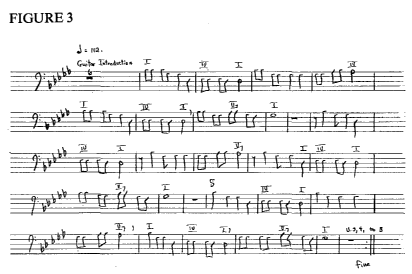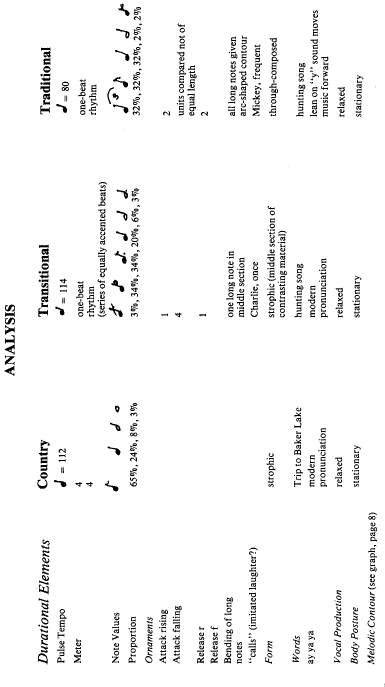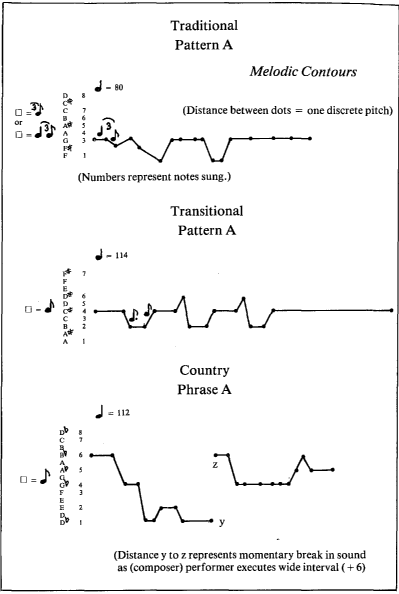
Canadian Journal for Traditional Music (1981)
Charlie Panigoniak: Eskimo Music in Transition
Abstract
As a result of fieldwork in Eskimo Point, Northwest Territories, in 1975, I concluded that homogenization of Inuit music was inevitable and that it would only be a matter of time before the traditional music vanished and all Inuit would become consumers and occasionally producers of popular music. But since that time, the songs of one singer-composer, Charlie Panigoniak, have caused mc to doubt the validity of my statement, "The two music styles of the old and young generations live side by side with no influence on one another." Others have reached similar conclusions about Eskimo music. Paul Rovsing Olsen concludes that in East Greenland ". . . the Eskimo attitude has been either one or the other. Two or more different styles are living side by side without influencing each other in any conceivable manner."2
If this is so, how can several of Charlie Panigoniak's songs be explained? Perhaps Charlie's disquieting songs arc evidence of the following thought of Claude Levi-Strauss: "The more a civilization becomes homogenized, the more internal lines of separation become apparent; and what is gained on one level is immediately lost on another."3 The purpose of this paper is to explore one of Charlie's songs which I believe can not be classified as either traditional or country, and which may be an example of Levi-Strauss's internal line of separation.
Charlie Panigoniak, in his mid-thirties, has become a performer and composer of repute in several Eskimo settlements. He lived in the traditional way until the late 1950s, when the Canadian government settled the starving inland Eskimos in several coastal communities, one of which is Eskimo Point. When Charlie was twenty-one, his father made him his first guitar from a tin can. Charlie is now a skillful manipulator of the country music idiom, frequently singing about Eskimo concerns while accompanying himself on the guitar.
Eskimo Point (62° N., 94° W.), a settlement of approximately 641 Inuit and 54 whites, lies on the western shore of Hudson Bay in the District of Keewatin. Situated on the southern edge of the barrens, a term for treeless, often rocky land, Eskimo Point is subjected to long, cold, and dark winters with little snow, and short, cloudy, cool, and wet summers. Brian J. Bird describes the Arctic as the world's harshest botanical environment.4
The inland Eskimo settled in the District of Kccwatin about a thousand years ago and continued their traditional lifestyle relatively undisturbed until the 1950s. Unlike the coastal Eskimo who underwent a prolonged transitional period from traditional to modern life, the Caribou Eskimo has endured a near-complete assimilation within twenty years. Traditionally the head of the family devoted himself to the hunt of the caribou. Now most residents find themselves dependent upon government welfare. Jobs are scarce, but a few of the residents find work mainly as unskilled laborers.
The Northwest Territories have the same communications as the rest of Canada such as telephone, telegraph, telex, and AM network radio. Since 1973 Anik satellite has supplied the north with television. Every Eskimo Point home, including Charlie's, has a radio. A few houses have record players and tape recorders. There remains much distrust of television, but telephones are exceedingly popular.
Of course change is dramatically manifested in Inuit material culture. Traditionally, animals were the source of clothing as well as of food. The clothing of today is as varied and up-to-date as the catalogue and local "Bay" store permit. Modern Inuit homes arc poor copies of southern homes. As in traditional times the Eskimo still eagerly awaits summer when he may move to his tent. In 1975 Charlie lived with his wife and family in a one-room house on the coast of the Hudson Bay. He practised guitar in the lobby of the nearby Roman Catholic church when his children were sleeping.
Eskimo Point has three churches, the Anglican, Roman Catholic, and Holy Alliance. Christianity is the accepted religion, and belief appears sincere, yet remnants of the traditional beliefs abound as the stories of the old people show. Charlie's songs reflect the variety of religious beliefs. Two of the fifteen songs which he sang have religious titles, "John 3:16, God so loved the world," and "My Lord and My God"; a third song mentions that God saved Charlie and his parents from starvation. Contrastingly, his "Dad's Song" tells of a talking seal — talking animals arc characteristic of the traditional tales.
During the long nights men and women told and retold their vast store of tales; tales which reinforced the Inuit religion and morals as well as the laws for social life. The younger generation no longer tell the stories and many arc uninterested in listening to them.
Like the stories, the drum dances were formerly a major part of Inuit life but are now neglected by the youth. The traditional drum dance song examined in this paper is sung by an elderly husband and wife, Mickey and Mary Kaschuk. Characteristically the song tells about hunting and makes reference to what the singer was thinking. Now the drum dances arc held infrequently, only on special occasions such as Christmas or New Year's. More popular is the Eskimo dance, a hybrid dance accompanied by country music.


At present the music enjoyed by the Inuit originated with white people. Hymns taught by the missionaries are household songs. Every settlement has its young singers with guitars who imitate the country sounds they hear on the radio. The guitar became popular after the Inuit moved to heated homes from their tents, but as in western society most persons are listeners, rather than performers of music.
With this background let's look at three songs which will show the nature of the musical problem. The first is the traditional drum dance song sung by Mickey and Mary Kaschuk.

1. I didn't want to take my gun
Because I thought it was too heavy
M'nay ya ay ya m'nay ay ya ay ya ya ya ay ya ya
M'nay ya ya ya ya ya ya
Mary Y'ya y'ya ya ya ya ya ay ya ay ya
Mickey oo-ec 00-cc ay ya ay ya*
2. I was walking around I didn't want to take my gun
Because I thought it was too heavy
3. I was wondering why I was thinking That my gun is heavy
4. I kept something in my mind as a secret
5. Near the hill
I kept something in my mind as a secret
The people are lucky
6. In winter I never do anything The people are lucky
7. I think that the people are lucky But I caught caribou
I think that I am smart
8. Near the hills I caught a caribou
*The remaining six connectives are similar.
Following is the song of questionable style, composed and sung by Charlie Panigoniak.


From a tent I go back and forth, in and out
Opening water in the ice-hole in ice
Animal seal, first time I saw a seal in open water
Everytime I tried to take the seal
I couldn't it was talking.
The third song is typical Charlie Panigoniak, but words telling about local places and events.
country style,
We went to Baker Lake
We went to sing
Hec hee haw haw
It's funny
There are too many people in Baker Lake
I used to laugh.

To determine the nature of the questionable song I initially analyzed the three songs with the aid of a checklist of music elements. The checklist showed many elements in common between Charlie's questionable song and the traditional song. One might conclude on the basis of the checklist that Charlie's song is traditional. For example:
1. Both rhythms are a series of equally accented beats, a one-beat rhythm.
2. They share a similar rhythmic pattern, , which is used with equal frequency.
3. Both contain more rising attacks and falling releases than the country song.
4. Both use similar intervals — major and minor seconds; major and minor thirds; perfect fourths.
By examining the surface structure of the songs through the reductionist, object-focussed nature of the checklist, convincing similarities are achieved between Charlie's song and the traditional song. But when one starts to look inside the music, it appears that the song is a conscious attempt to sing in traditional style, that it is a song sung in traditional style, but it is not a traditional song. The most convincing evidence that Charlie's song is not traditional comes through a more intuitive, anthropological search of the deep structures of the song, particularly through an examination of Charlie's concept of time as it is manifested in the music.
The overall difference in time concepts evidence in the music may be described as cyclical versus linear. The traditional song is cyclical in a time sense. There are also places where it evinces a timeless, static quality.
The Kaschuks, as well as other of the Eskimo Point singers, believed that the best music was made by a husband-wife singing together. Certainly their duo performance helps to achieve a cyclical time movement since the music is not punctuated by rests, rather the voices interplay without cessation. In contrast, Charlie sings alone. His phrases are clearly delineated by rests, the rests coinciding with his breaths.
The traditional Kaschuk song consists of four different patterns repeated nine times with no apparent planned ending; they stop singing when they tire, and with no climatic point in the song. Charlie's song is symmetrically balanced (fig. 2) with a middle section which acts as a climax, following closely the narrative curve, a pattern of progress, characteristic of most western art form.5 His conclusion is easily anticipated by one enculturated in the west, and the song is the proper length to hold our attention throughout.
The usual description of Eskimo music as slow fits the Kaschuk song. Indeed the equal emphasis of each beat imparts a static quality, as does the intensity of their vocal production. The sense of forward movement, of progress evident in Charlie's song, is absent in the Kaschuk song. The tempo of Charlie's traditional song is


close to that of his country songs, a sprightly tempo which dictates the lessening of vocal intensity and which reinforces the linear movement.
The timelessness of the Kaschuk rhythm is offset by the cyclical time created by the vocables, ay ya ya. Eskimo song is often given the appellation ay ya ya. By singing on the y consonant the voice is constantly propelled forward, imparting a cyclical movement. Charlie's vocables are sung cleanly, crisply, and do not contribute to the movement of the music.
On the basis of Charlie's fundamentally different approach to the use of time in music one can state that this is not a traditional song, a song in traditional style perhaps, and definitely a skillful blend of old and new elements.
Besides differences in time, one can speculate from the music that the function of the two songs is quite different. Charlie's song is a performance in true western sense. He takes pains to imitate the drum by tapping his guitar; his song is the proper length to hold our attention. Characteristic of the western aesthetic is the framing or bounding of the performance in space from the audience. There is more emphasis on the product than on the process.
The Kaschuk song is improvisatory; Mary Kaschuk even talks during the song. The phrases are changed slightly with each repetition. They are not creating a finished product. For example, they make no attempt to imitate the drum, but are enjoying the process of singing, not creating an exemplary drum dance song.
With the rapid acculturation of the Caribou Eskimo and the loss of the traditional functions of the drum dance songs, the total loss of ability to create songs in traditional style is possible. But happily we have in Charlie's song a transitional style — a style which may have opportunity to flourish in the current native awareness movement. Perhaps Charlie's efforts to sing in the traditional way are a good measure of the Inuit's renewed integrity, renewed pride in himself, and in his past and present ability to survive in one of the world's harshest environments.
Université de Montréal
Montréal, P.Q.
FOOTNOTES
1 Whidden, Lynn, "Three Generatious of Eskimo Songs from Eskimo Point, Northwest Territories," anpabtished M.A. paper, Univ. of Minnesota, 1976.
2 Paul Rovsing Olson, "Acculturation in the Eskimo Songs of the Greenlanders," Yearbook of the International Folk Music Council, 4(1972).
3 Claude Levi-Strauss, Myth and Meaning (Toronto: Univ. of Toronto Press, 1978), P.20.
4 Brian J. Bird, The Physiography of Arctic Canada (Baltimore: Joltn Hopkins Press, 1967)
5 Barney Childs, "Time and Music: A Composer's View," Perspectives of New Music (Hamilton Printing Co., 1977), 194-219.
Résumé: Lynn Whidden analyse les chants de Charlie Panigoniak pour illustrer les genres de changements qui se produisent dans la musique Inuit d'aujourd'hui. Elle constate que l'un de ses chants est interprété dans le style traditionnel et comporte des éléments anciens et nouveaux, mais qu 'en réalité, il n'est pas un chant vraiment traditionnel en raison d'une facon différente d'utiliser la notion de temps en musique. Un autre de ses chants s'apparente plus au genre de musique Western.
© Canadian Journal for Traditional Music